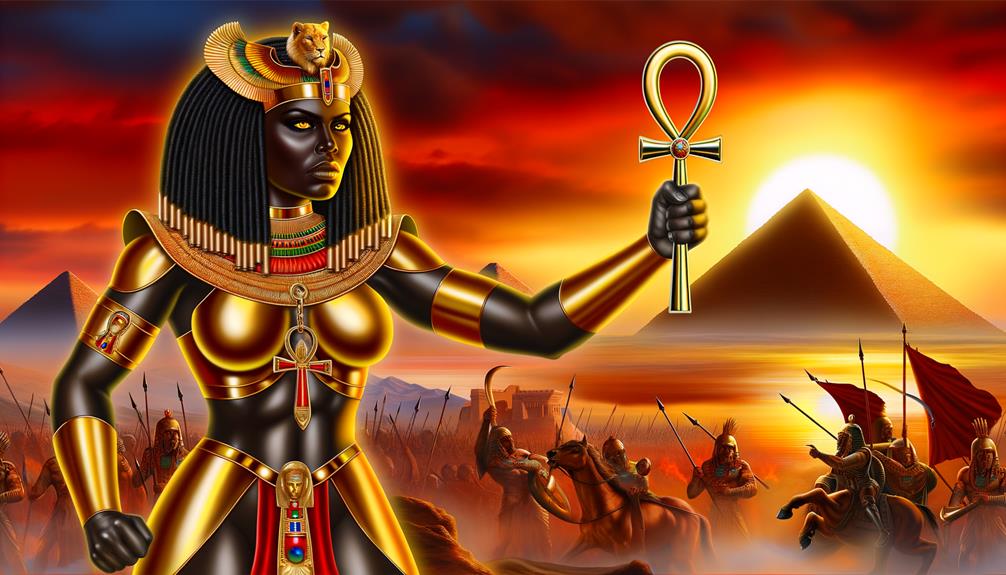Sekhmet, the Egyptian goddess of war, is a figure shrouded in many intriguing legends. She's not just a simple counterpart to the Greek god Ares, she's way more layered and multifaceted. This goddess embodies a fascinating paradox, reflecting the complex and often contradictory nature of the universe itself.
Sekhmet doesn't just symbolize destruction and war. She's also known as a fierce lioness, a bringer of divine punishment, a spreader of diseases, and surprisingly, a healer. It's fascinating to see how these different aspects weave together to form a complex character.
These legends are not just entertaining stories. They also give us an insight into how the ancient Egyptians saw the world and their role in it. So, let's dive in, shall we? Let's take a trip back to the distant past, and see what these tales have to tell us about the divine. It's going to be an enlightening journey, so buckle up!
The Ferocious Nature of Sekhmet

Let's talk about Sekhmet, the ferocious Egyptian Goddess. She's quite the paradox, stirring up chaos while also offering healing. This makes her a complex figure in ancient Egyptian mythology. Sekhmet, also known as the 'Destroyer of Rebellion', was held in high regard by pharaohs due to her power and aggression. They looked up to her as a military idol. Her annual festival was filled with rituals that highlighted her mighty warrior spirit, making her a fearsome representation of Ras and the daughter of Ra.
But don't let her intimidating title as the Mistress of Dread fool you. Sekhmet was also seen as a protector of cosmic balance, despite symbolizing danger and disorder. People thought she regulated the population by letting loose plagues – her so-called messengers or slaughterers. However, she wasn't just about destruction. As the Mistress of Life, Sekhmet was believed to have the ability to fend off illnesses and cure the sick.
Her dual nature makes Sekhmet a fascinating figure in Egyptian mythology. She represented the scorching desert winds and was associated with illness and plague. Yet, she was also seen as a source of healing and safeguarding. This duality paints a vivid picture of her role in ancient Egyptian tales.
Sekhmet's Role in Egyptian Mythology
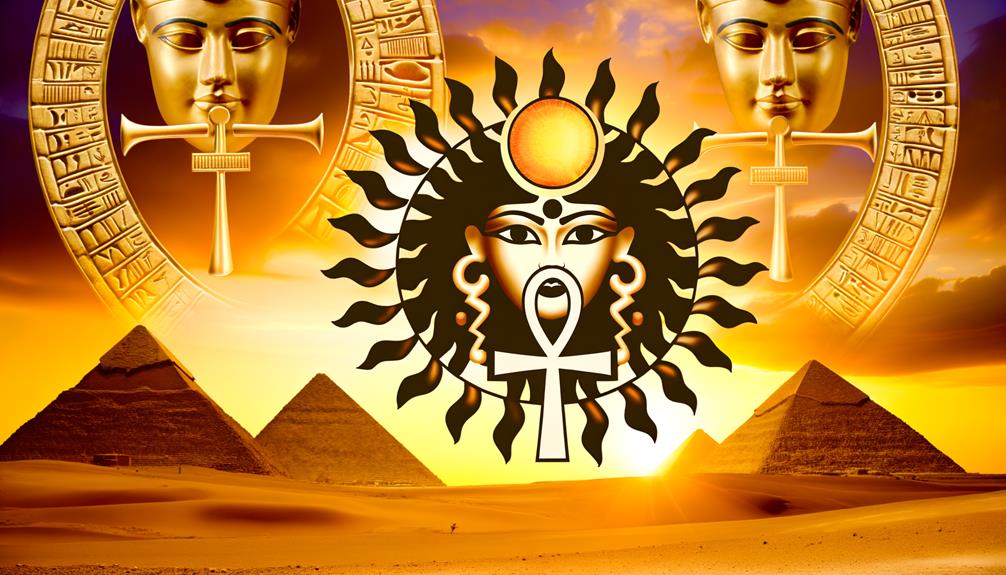
Sekhmet, a figure from Egyptian mythology, holds a complex and intriguing role. This ancient Egyptian goddess has a unique dual nature. On one hand, she represents the fierce power of the desert sun and war, but on the other hand, she symbolizes healing and the prevention of natural disasters. She's a standout personality among other Egyptian deities, often depicted as a woman with the head of a lioness.
The ancient Egyptians held a healthy respect and fear for Sekhmet's destructive side. In their eyes, she was the physical manifestation of the ruthless desert sun, bringing war and disease in her wake. However, she wasn't all doom and gloom. Interestingly, she was also considered to be a protector of physicians, being able to cure the very diseases she was capable of causing. This healing aspect of her nature is a stark contrast to her destructive side, showcasing the depth of her character.
Sekhmet also played a key role in managing the Nile's flooding, which helped avert natural disasters. This meant that while she had a reputation for being violent and fierce, she was also seen as a protective deity. She shielded the Egyptians from the wild elements, demonstrating that there was more to her than met the eye.
Unveiling Sekhmet's Destructive Power
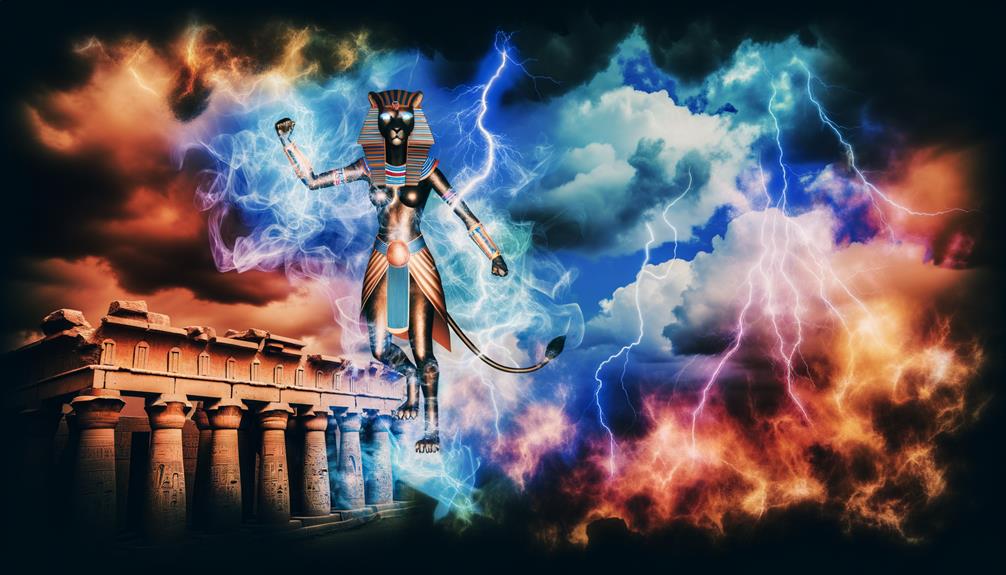
Sekhmet's protective and healing traits offer a well-rounded view, yet it's her mind-blowing destructive power that truly sets her apart in Egyptian mythology. Shining a spotlight on this aspect of Sekhmet takes us deep into the core of ancient Egyptian faith, where it's believed her fury was a formidable force.
- Uniquely among the Egyptian pantheon's feline gods, Sekhmet personified the 93 diseases known to the ancients.
- She was linked to the sun god, Ra, which boosted her destructive capabilities. When humans ignored Ra's laws, she was his go-to to discipline the defiant mortals.
- Allegedly, Sekhmet went berserk, her thirst for blood becoming so extreme that she almost obliterated the human race.
- Her title, 'One who loves Maat' (truth and justice), underscores her part in preserving cosmic order, even if it necessitated devastation.
- Finally, the fact that Sekhmet could only revert to Hathor, a more peaceful deity, through trickery, underscores her indomitable power.
Sekhmet: Goddess of Disease and Healing
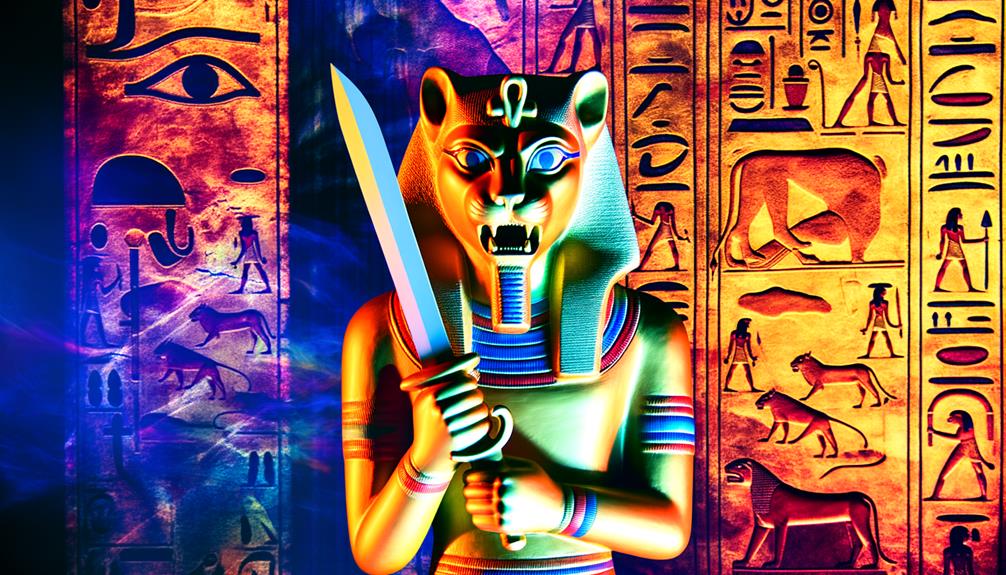
Sekhmet, a figure from Egyptian myth, holds a unique place as both a bringer of disease and a healer. She's often depicted as a red, feline goddess with a woman's body, and is considered the offspring of the earth god, Geb. Her power stems from Ra, the sun god, making her a significant force. Her title, the 'Lady of Pestilence,' embodies her power to spread disease, a characteristic that aligns with her role as the 'eye of Ra', where she functions as an instrument of divine punishment.
But there's more to Sekhmet than just this. She's also seen as a patron of artisans, doctors, and healers, implying that she represents healing and defense against sickness. This dual aspect is a key to understanding the intricate nature of ancient Egyptian religious beliefs, where gods were neither entirely benevolent nor entirely malevolent.
The contrast in Sekhmet's roles can be compared to the sun's dual nature – its ability to both nurture life and cause damaging droughts. Sekhmet, with her dual character, mirrors the interweaving of life and death, and the recurring pattern of existence. Her story serves as a potent reminder that creation and destruction are two aspects of the same reality.
Intriguing Legends of Sekhmet
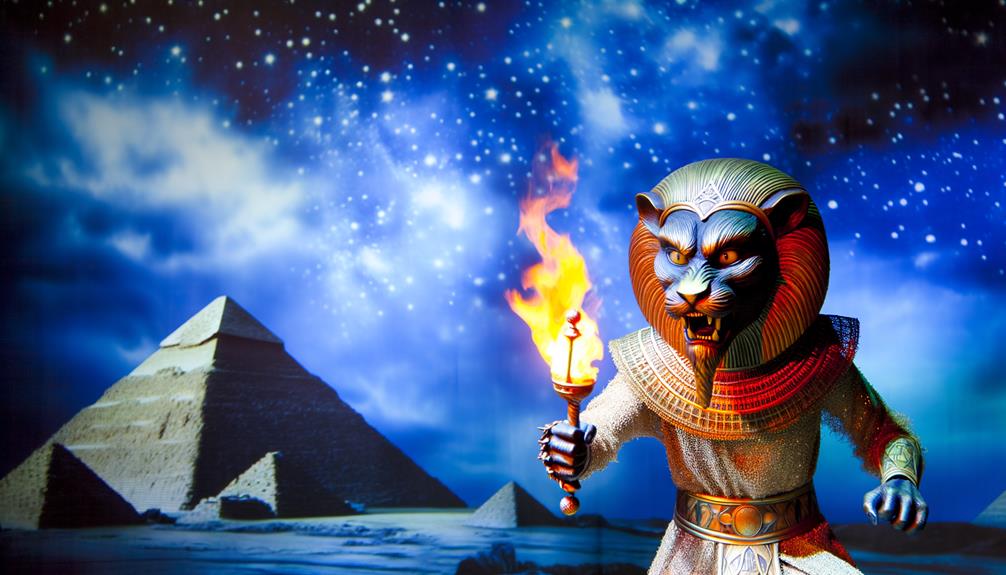
Diving into the fascinating tales of Sekhmet, we uncover a rich array of narratives that paint her as a multifaceted figure – a war goddess, a protector, and a healer. Her roles shift from being the terrifying Lady of the Tomb to the gentle Mistress and Lady.
Here's what her stories say:
- Sekhmet, consumed by her desire for blood, almost wiped out humanity. Hathor, another goddess, had to fool Sekhmet with beer dyed red to calm her down.
- Hundreds of her statues stood in Amenhotep III's burial temple, signifying her role as the guardian in the afterlife.
- Her role at the Battle of Kadesh shows her significant impact in wartime.
- As the Mistress of Life, she embodied both destruction and healing.
- The festival for her and Bastet aimed to control the Nile's rampant flooding, indicating her role in keeping things balanced.
These tales of Sekhmet as a war goddess present a goddess full of contrasts – destructive yet caring, frightening yet comforting. This complexity is what makes Sekhmet's stories so captivating, underscoring the intricate ties within ancient Egyptian religious beliefs.
Frequently Asked Questions
How Was Sekhmet Viewed in War?
Let's talk a bit about how Sekhmet, a notable figure in ancient Egypt, was perceived during times of war. Regarded as a warrior's deity, Sekhmet's symbols were proudly carried into battle by the pharaohs. They had a belief that her breath was identical to the scorching desert winds. This goddess was essentially a testament to the pharaoh's strength, and her presence was enough to strike fear into the hearts of their adversaries.
Why Was Sekhmet Goddess of War and Healing?
You might be curious about Sekhmet's dual identity as both a goddess of war and healing. This combination isn't exactly out of the ordinary when you look at different mythologies. When it comes to battle, Sekhmet doesn't hold back – her fierceness is legendary. But she also has a tender side, showing compassion and care when it's time for healing. This balance, while seeming contradictory, actually mirrors the rhythm of life itself – the ebb and flow of destruction and rebirth. It might seem like a paradox, but there's a real harmony in it.
Who Did Sekhmet Fight?
In the old tales from Egypt, it was humans that Sekhmet had a bone to pick with. She was absolutely livid at their lack of respect and sheer disregard for the gods. This anger almost wiped humanity off the map, thanks to her fiery temper and destructive streak.
What Is the Myth of Ra Sekhmet?
Ever heard about the tale of Ra and Sekhmet? It's quite an interesting one. In this story, Ra, being fed up with the disobedience of humans, brings Sekhmet into existence as a form of punishment. She almost wipes out the entire human race, but Ra, being crafty as ever, gets her to sip some beer dyed red. It gets her tipsy, and voila! Sekhmet transforms into the much more approachable Hathor.

